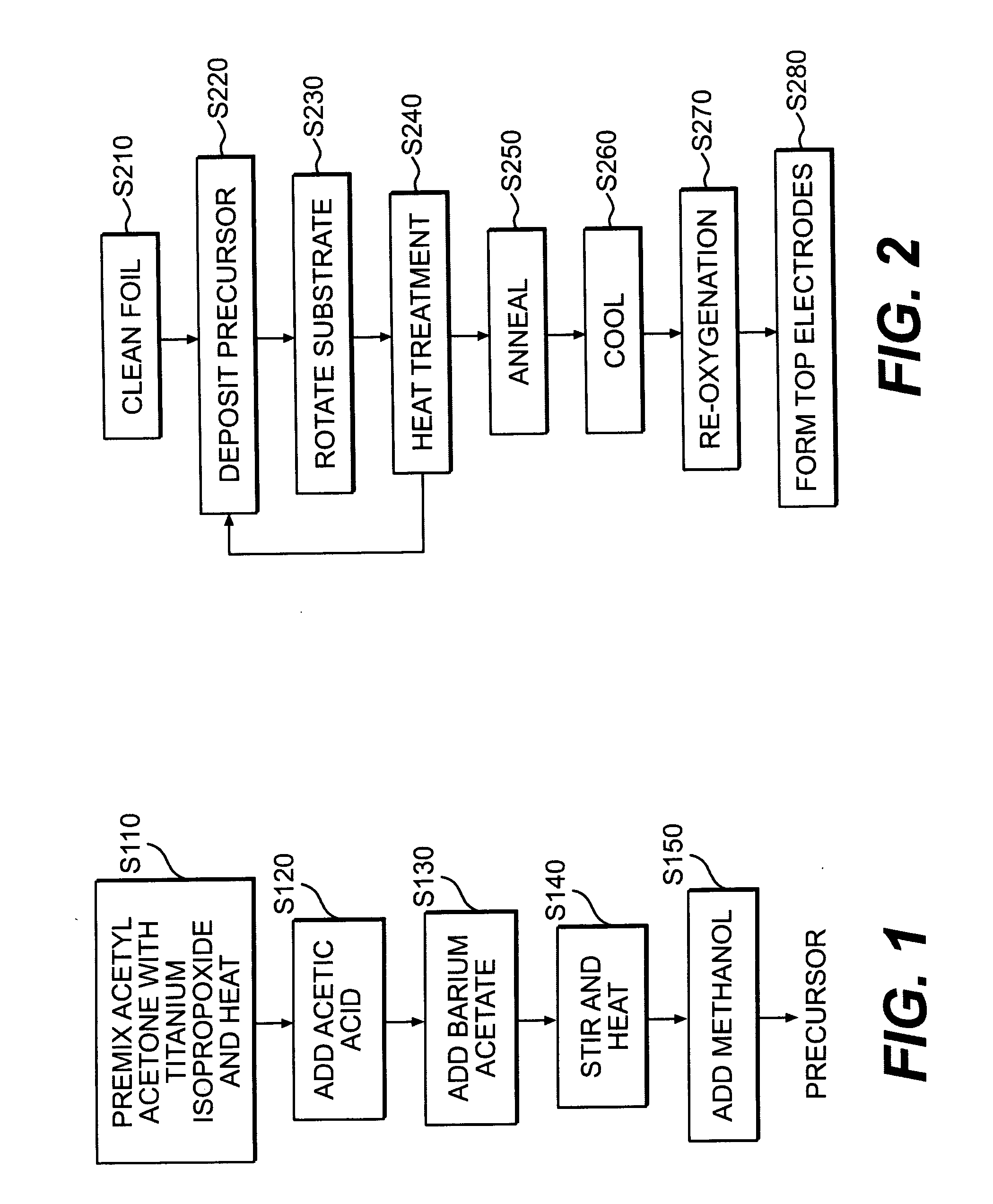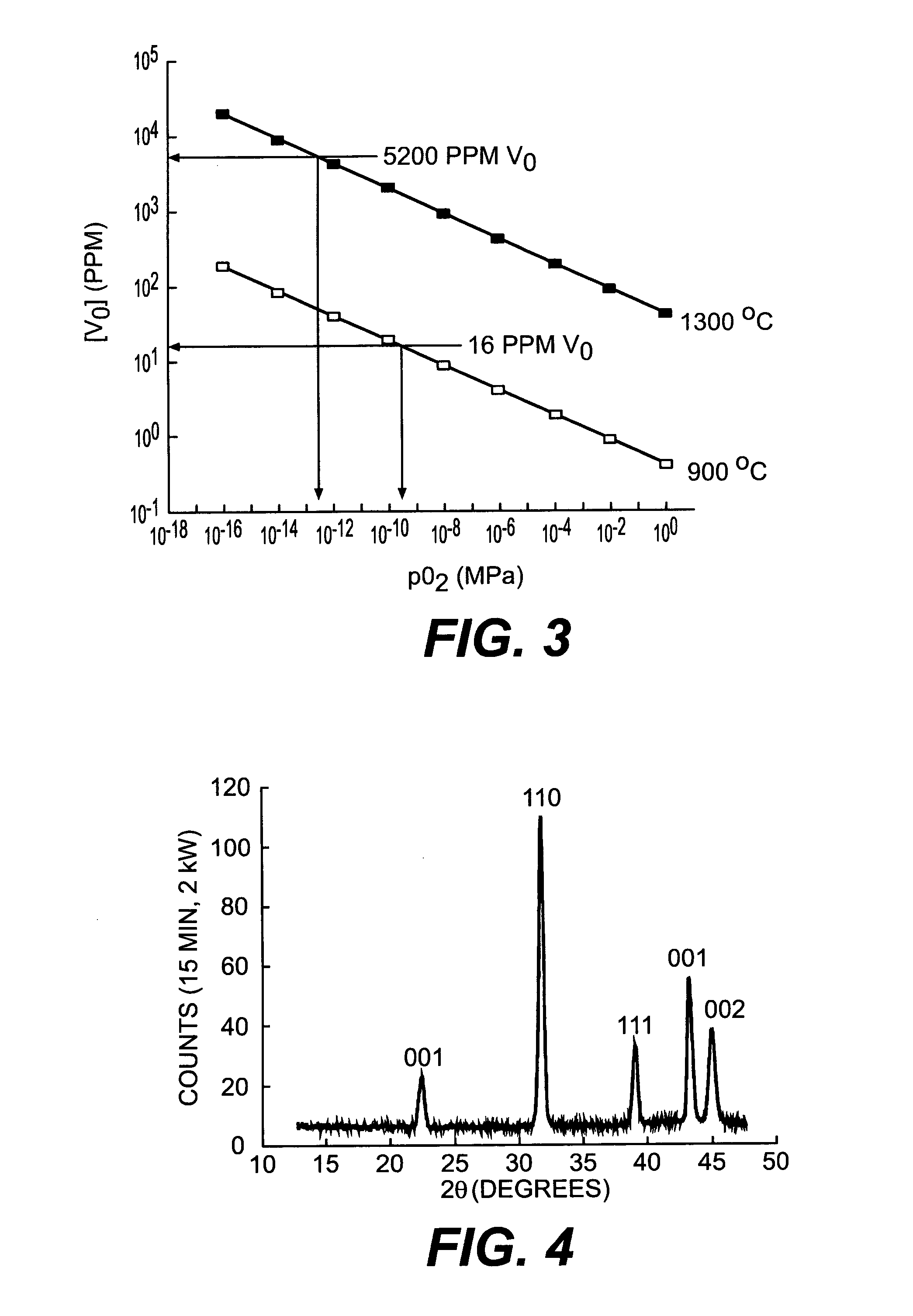Thin film dielectrics for capacitors and methods of making thereof
- Summary
- Abstract
- Description
- Claims
- Application Information
AI Technical Summary
Benefits of technology
Problems solved by technology
Method used
Image
Examples
example 1
Barium Titanate (BaTiO3) Dielectric Produced Directly on Copper Foil
[0063] A fired-on-foil thin film undoped BaTiO3 dielectric was formed from the following precursor solution:
Barium acetate2.6gTitanium isopropoxide2.9mlAcetylacetone2.0mlAcetic acid10.0mlMethanol15ml
[0064] The precursor solution was prepared and deposited on a clean 0.5 oz. copper foil as described with reference to FIGS. 1 and 2. No dopants were added to the precursor solution. Annealing was performed at 900° C. for 30 minutes in an atmosphere containing a partial pressure of oxygen of 10−10 atmospheres. The annealed thickness of the resultant dielectric was approximately 0.5 micron. Re-oxygenation was performed at 600° C. for 20 minutes in an atmosphere containing a partial pressure of oxygen of 10−7 atmospheres. A top platinum (Pt) electrode was sputtered onto the dielectric.
[0065]FIGS. 4-7 show experimental data collected for the undoped BaTiO3 capacitor prepared on copper foil according to Example 1. FIG. 4...
example 2
Yttria-Doped Barium Titanate Dielectric
[0075]FIG. 9 is a plot of measured permittivity (upper data set) and loss tangent (lower data set) versus bias voltage for a thin film Y-doped BaTiO3 capacitor prepared on a copper foil substrate. Data was collected during the voltage ramp up and during the ramp down. The overlapping curves illustrate the expected hysteresis behavior. A high permittivity value of approximately 1600 was achieved with yttrium doping.
[0076] The dielectric was prepared by adding 1 mol % Y to the precursor solution as described in Example 1. The precursor was then solution-deposited to form a dielectric layer. Annealing and re-oxygenation of the dielectric layer was performed as in Example 1. The resultant dielectric composition is described generically as: (Ba1-xYx)(Ti1-yYy) O3 where 0<x<1 and 0<y<1. The specific precursor solution composition was:
Barium acetate2.6gYttrium acetate0.27gTitanium isopropoxide2.9mlAcetylacetone2.0mlAcetic acid10.0mlMethanol15ml
[007...
example 3
Barium Titanate Dielectric Prepared on Platinum Foil
[0078] In Example 3, a thin film BaTiO3 dielectric film was prepared on a platinum foil substrate, rather than a copper foil. The BaTiO3 dielectric was formed in a manner similar to that of Example 1. The x-ray line widths, from which grain size is calculable, were identical for the dielectric formed on platinum as for the BaTiO3 dielectric formed on copper foil. Accordingly, the x-ray line widths indicate average dielectric grain sizes in the range of 0.1-0.2 micron, and high crystallinity. Choice of foil material therefore appeared to have little or no effect on grain size.
PUM
| Property | Measurement | Unit |
|---|---|---|
| Temperature | aaaaa | aaaaa |
| Temperature | aaaaa | aaaaa |
| Temperature | aaaaa | aaaaa |
Abstract
Description
Claims
Application Information
 Login to View More
Login to View More - R&D
- Intellectual Property
- Life Sciences
- Materials
- Tech Scout
- Unparalleled Data Quality
- Higher Quality Content
- 60% Fewer Hallucinations
Browse by: Latest US Patents, China's latest patents, Technical Efficacy Thesaurus, Application Domain, Technology Topic, Popular Technical Reports.
© 2025 PatSnap. All rights reserved.Legal|Privacy policy|Modern Slavery Act Transparency Statement|Sitemap|About US| Contact US: help@patsnap.com



